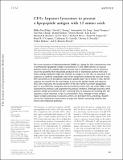| dc.contributor.author | De Jong, Annemieke | |
| dc.contributor.author | Vazquez, Jenny | |
| dc.contributor.author | Cheng, Tan-Yun | |
| dc.contributor.author | Barral, Duarte C. | |
| dc.contributor.author | León, Luis | |
| dc.contributor.author | Riese, Richard | |
| dc.contributor.author | Costello, Catherine E. | |
| dc.contributor.author | Porcelli, Steven A. | |
| dc.contributor.author | Briken, Volker | |
| dc.contributor.author | Van Rhijn, Ildiko | |
| dc.contributor.author | Young, David C. | |
| dc.contributor.author | Talekar, Rahul Subhash | |
| dc.contributor.author | Brenner, Michael Barry | |
| dc.contributor.author | Katz, Joel Thorp | |
| dc.contributor.author | Ruprecht, Ruth Margrit | |
| dc.contributor.author | O'Connor, Peter B. | |
| dc.contributor.author | Moody, D Branch | |
| dc.date.accessioned | 2011-12-29T22:51:39Z | |
| dc.date.issued | 2009 | |
| dc.identifier.citation | Van Rhijn, Ildiko, David C. Young, Annemieke De Jong, Jenny Vazquez, Tan-Yun Cheng, Rahul Talekar, Duarte C. Barral, et al. 2009. CD1c bypasses lysosomes to present a lipopeptide antigen with 12 amino acids. The Journal of Experimental Medicine 206(6): 1409-1422. | en_US |
| dc.identifier.issn | 0022-1007 | en_US |
| dc.identifier.uri | http://nrs.harvard.edu/urn-3:HUL.InstRepos:5978709 | |
| dc.description.abstract | The recent discovery of dideoxymycobactin (DDM) as a ligand for CD1a demonstrates how a nonribosomal lipopeptide antigen is presented to T cells. DDM contains an unusual acylation motif and a peptide sequence present only in mycobacteria, but its discovery raises the possibility that ribosomally produced viral or mammalian proteins that commonly undergo lipidation might also function as antigens. To test this, we measured T cell responses to synthetic acylpeptides that mimic lipoproteins produced by cells and viruses. CD1c presented an N-acyl glycine dodecamer peptide (lipo-12) to human T cells, and the response was specific for the acyl linkage as well as the peptide length and sequence. Thus, CD1c represents the second member of the CD1 family to present lipopeptides. lipo-12 was efficiently recognized when presented by intact cells, and unlike DDM, it was inactivated by proteases and augmented by protease inhibitors. Although lysosomes often promote antigen presentation by CD1, rerouting CD1c to lysosomes by mutating CD1 tail sequences caused reduction in lipo-12 presentation. Thus, although certain antigens require antigen processing in lysosomes, others are destroyed there, providing a hypothesis for the evolutionary conservation of large CD1 families containing isoforms that survey early endosomal pathways. | en_US |
| dc.language.iso | en_US | en_US |
| dc.publisher | The Rockefeller University Press | en_US |
| dc.relation.isversionof | doi:10.1084/jem.20082480 | en_US |
| dc.relation.hasversion | http://www.ncbi.nlm.nih.gov/pmc/articles/PMC2715062/pdf/ | en_US |
| dash.license | LAA | |
| dc.title | CD1c Bypasses Lysosomes to Present a Lipopeptide Antigen with 12 Amino Acids | en_US |
| dc.type | Journal Article | en_US |
| dc.description.version | Version of Record | en_US |
| dc.relation.journal | The Journal of Experimental Medicine | en_US |
| dash.depositing.author | Van Rhijn, Ildiko | |
| dc.date.available | 2011-12-29T22:51:39Z | |
| dash.affiliation.other | HMS^Medicine-Brigham and Women's Hospital | en_US |
| dash.affiliation.other | HMS^Biological Chemistry and Molecular Pharmacology | en_US |
| dash.affiliation.other | HMS^Medicine-Brigham and Women's Hospital | en_US |
| dash.affiliation.other | HMS^Medicine-Brigham and Women's Hospital | en_US |
| dc.identifier.doi | 10.1084/jem.20082480 | * |
| dash.authorsordered | false | |
| dash.contributor.affiliated | Van Rhijn, Ildiko | |
| dash.contributor.affiliated | Talekar, Rahul Subhash | |
| dash.contributor.affiliated | Moody, David | |
| dash.contributor.affiliated | Ruprecht, Ruth Margrit | |
| dash.contributor.affiliated | Katz, Joel | |
| dash.contributor.affiliated | Brenner, Michael | |


